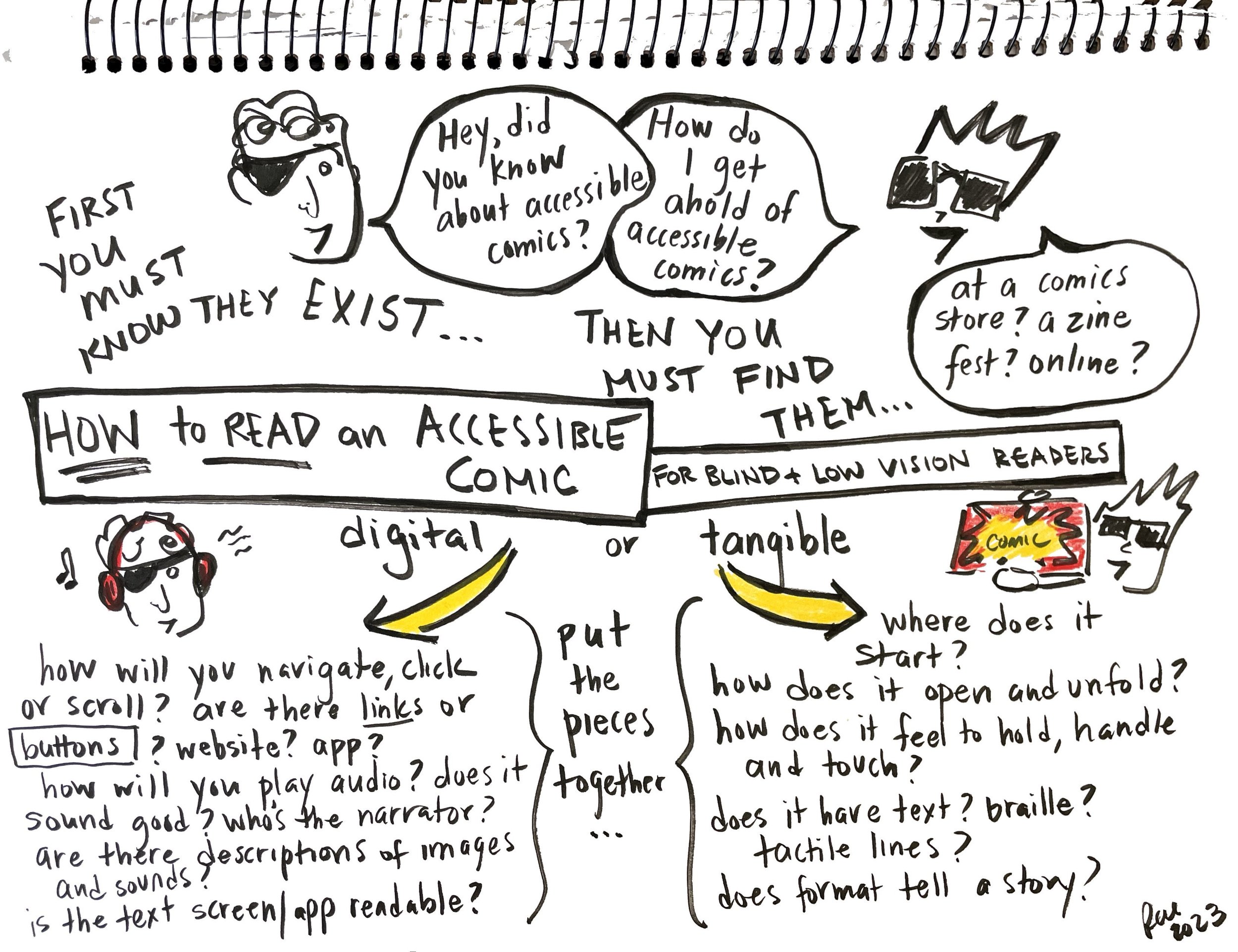How to…
In 2022, I started making comics and exploring how to make them accessible for low vision and blind readers. I had embraced comics a few months before as a result of sudden vision loss. When I sat down in April 2023 to prepare a short presentation about many months’ work on this, I gathered reflections about my process, challenges, and calls to action. I scrawled my ideas onto these two pages: “How to make a comic designed accessible,” and “How to read an accessible comic for blind and low vision readers.” Maybe they’re comics? They’re a bit tongue-in-cheek and aren’t very legible, tho I have image-described them in a linked PDF doc too, if you want to read it, as well as at the bottom of this page as text that should be more screen-readable I hope.
Descriptions:
Image 1: “HOW TO MAKE A COMIC DESIGNED ACCESSIBLE”
This notebook page with a section of spiral, metal binding at its top, is filled with word bubbles and a handwritten, numbered list. The list is partially obscured by a black line drawing of a hand holding a pen. (The drawing is from Embodied, a memoir comic by Rae Lanzerotti, 2023.)
The title across the top of the page reads, “How to make a comic designed accessible.”
A speech bubble below the word “make” contains this text: Embodied, a memoir comic, Rae Lanzerotti, 2023. A speech bubble below the word “comic” contains this text: “What is a comic anyway?” A speech bubble below the word “accessible” contains this text: “for blind and low vision readers.”
Here is the list of ideas, hand-written nonlinearly, although numbered 1 to 18. The list covers the page:
Lose vision
Find comics
Start making comics and memoir about vision loss during the early pandemic
Find *community* [stars around the word “community” add emphasis]
Draw, draw, record, draw, redraw
Decide to try ALL the things [a speech bubble beneath this contains the text: “line drawings, audio, text, ID/SD, tactile shapes, web page, Braille, IG, perzine, embossing, puff paint, letterpress, swell)
Make closet a recording booth
Tactile testing begins...
Say you’ll never use QR codes
Realize you need a QR code
Edit, write, rerecord, redraw, freak out, celebrate, repeat
Decide to make a touchable comic
Realize you need to build a website
Ponder artistic and standard Braille options and words
Try a lot of printed prototypes
Test with blind readers
Re-test tactiles
Sixteen posts on IG
Small print text below the list reads:
*not necessarily in this order* [stars around this phrase add emphasis] Signed: Rae, 2023
Image 2: “HOW TO READ AN ACCESSIBLE COMIC, FOR BLIND AND LOW VISION READERS.”
With black ink on white paper from a spiral-bound notebook, a handwritten jumble of words, phrases, and questions fills this page.
Across the center of the page two boxes present the title, in capital letters: “HOW TO READ AN ACCESSIBLE COMIC, FOR BLIND AND LOW VISION READERS.”
Above, in the top right and left corners of the page, two comics characters speak. On the right, wearing an eye patch, a curly-haired person asks, “Hey, did you know about accessible comics?” On the left wearing dark sunglasses, a spiky-haired person asks, “How do a get ahold of accessible comics? At a comics store? A zine fest? Online?”
Their questions yield to floating text:
FIRST YOU MUST KNOW THEY EXIST... THEN YOU MUST FIND THEM...
Below, dividing the bottom portion of the page, a narrow central section with vertical text reads: “put the pieces together...”
Bracketed to the left side of this, the curly-haired person with an eye patch now wears red headphones with symbols for sound and music emanating from them. The word “digital,” next to a yellow arrow, points to a list of questions: “How will you navigate, click or scroll? Are there links or buttons? Website? App? How will you play audio? Does it sound good? Who’s the narrator? Are there descriptions of images and sounds? Is the text screen/app readable?
Bracketed to the right side, the spiky-haired person with dark sunglasses holds a red and yellow book with the word “comic” on its cover. The word “tangible,” next to a yellow arrow, points to a list of questions: “Where does it start? How does it open and unfold? How does it feel to hold, handle and touch? Does it have text? Braille? Tactile lines? Does format tell a story?”
Rae, April 2023.

